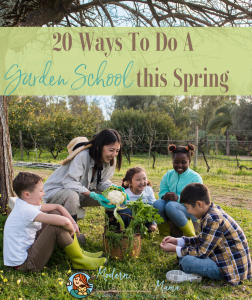By Danielle, contributing writer
Maybe you want to find more time outside. Maybe you want your children to have more hands-on learning. Perhaps you just want to finally have that garden, but you struggle finding the time. Maybe it’s time to make your homeschool a garden school!
Real life homeschooling is where real learning happens — so, rethink your spring homeschool plans. Children need fresh air, sunshine, and practical learning. Centering your homeschool around your garden can help you actually get to the garden while teaching your children valuable life skills, and even reading, writing, and arithmetic.
20 Ways to To Do a Garden School This Spring
- Toss out your regular curriculum and instead use these activities for the different seasons. Record all of your garden happenings in your own garden journal — from information on the seeds, to garden layouts and plans, and research on specific plants. Have a place to record growth, weather, harvest date, and yield. Calculate your cost versus the grocery store price for the same produce and see how much money you saved.
- Plant seeds indoors in small jars or egg cartons and do a unit study on the plant life cycle.
- Grab plant identification books to see what is outside or in your local forest preserve.
- Bring in leaves and flowers from your plants, and then sketch them onto paper or clay pots.
- Develop your kid’s arithmetic skills by using multiplication and addition to figure out how many plants are in each row, and how many total plants will be grown.
- Make a chart of the days to maturity, germination temperature, days to plant after frost, etc. from your seed packets.
- Learn what minerals are needed for which plants (and what they do for your body, too!).
- Borrow a Farmer’s Almanac and understand the complexities of gardening.
- Even small children can get involved by using vegetables to teach colors, counting, and eating!
- Learn about the different types and parts of soil, and how minerals affect plant growth.
- Draw and study the water cycle while measuring how much rain your plants get in a given time.
- Try out new recipes with the plants you produce and be sure that your students do the measuring!
- Graph out your harvest per plant (or, graph out which veggies your family members like best!).
- Teach your children how to can or freeze produce. This can be an educational lesson on how people preserved food before electricity as well as an important option today.
- Find or purchase worms, feed them, and introduce them into your garden after studying their life cycle and how they benefit the soil. You can even make a worm farm!
- Save bark and leaves for crayon rubbings or texture paintings.
- Visit a local farm and volunteer to do farm chores for the day (or semester!).
- Study seeds and vegetables from other countries and heirloom seeds from ancient cultures. Asian countries have interesting plants, and native American corn can be found and grown, too.
- Have your older children start their own garden business with a produce stand.
- Study the garden zones and how the sun travels throughout the year.
I encourage you to think outside of the box with your homeschool lessons and find how you can incorporate real life and learning. Doing a garden school this spring is the perfect way to do that, while learning a lot and saving money on groceries.



Awesome, great tips! Thank you! 🙂